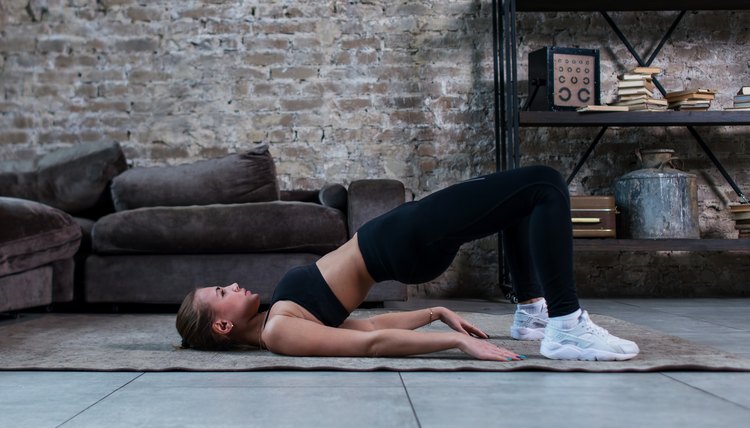What does fact checked mean?
At SportsRec, we strive to deliver objective content that is accurate and up-to-date. Our team periodically reviews articles in order to ensure content quality. The sources cited below consist of evidence from peer-reviewed journals, prominent medical organizations, academic associations, and government data.
- American Council on Exercise: Glute Bridge
- American Council on Exercise: Stability Ball Shoulder (Glute) Bridge
The information contained on this site is for informational purposes only, and should not be used as a substitute for the advice of a professional health care provider. Please check with the appropriate physician regarding health questions and concerns. Although we strive to deliver accurate and up-to-date information, no guarantee to that effect is made.
Hamstring Bridge Exercise

Bridge exercises use your body weight and mechanics to strengthen and tone your hamstrings, as well as work your buttocks, hips, thighs and core. This move is effective for people with knee or hip injuries because it strengthens the hamstrings — located on the front of the thigh — without putting any additional stress on your joints.
1. Standard Hamstring Bridge
The traditional hamstring bridge is accessible to beginners, but effective for individuals of all fitness levels. The standard bridge also establishes the foundation for more challenging bridges.
HOW TO DO IT: Lie on your back with your knees bent and your feet resting on the floor. Keep your knees and feet hip-width apart throughout the exercise, your toes facing forward and your ankles directly below your knees.
Stretch your arms straight beside your torso with palms facing downward. Press through your heels and lift your hips off the mat. Contract your hamstrings and squeeze your buttocks together. Pause at the top of the bridge position for 20 to 40 seconds. Release your hips back to the floor.
2. Hamstring Bridge with Pulse
By pulsing your hips while in bridge position, you repeatedly contract and release your hamstring and buttock muscles.
HOW TO DO IT: Enter the standard hamstring bridge position. At the top of the bridge, pulse your hips by squeezing and releasing your buttocks. Do 10 to 20 pulses per set. Then release your hips back to the floor.
3. One-Legged Hamstring Bridge
This isolates the muscles of the supporting leg and produces a more intense workout.
HOW TO DO IT: Enter the standard hamstring bridge position. At the top, lift one leg until the bottom of your foot is pointing toward the ceiling. Keep your raised leg straight in the air and immobile throughout the exercise. Lower your hips for two counts. Then raise your hips for two counts. Upon completing your set, lower your leg and then your hips back to the floor. Repeat this exercise on each leg five to 10 times per set.
4. One-Legged Hamstring Bridge with Leg Lift
This engages your supporting hamstring to stabilize your hips while pushing them up.
HOW TO DO IT: Start in the standard hamstring bridge position. At the top, lift one leg until the bottom of your foot is pointing toward the ceiling. Keep your hips steady and immobile at the top of the bridge throughout the exercise.
Keep your raised leg straight as you lower it toward the mat, pause for one count, then raise it up toward the ceiling. Repeat this exercise on each leg five to 10 times per set.

Work those hamstrings!
5. Hamstring Bridge with Stability Ball
This trains your hamstrings to stabilize your hips while in an unstable position.
HOW TO DO IT: Lie on your back with your legs bent and your feet resting on the ball. Lift your hips off the mat as you would in the standard hamstring bridge. Pause at the top of the bridge for one count. Lower your hips toward the floor, but do not let them touch. Press your hips back to the top of the bridge. Repeat this exercise five to 10 times per set.
Explore In Depth
References
- Yoga Basics: Bridge Pose
- American Council on Exercise: Glute Bridge
- American Council on Exercise: Stability Ball Shoulder (Glute) Bridge
- Lehecka BJ, Edwards M, Haverkamp R, et al. Building A Better Gluteal Bridge: Electromyographic Analysis Of Hip Muscle Activity During Modified Single-leg Bridges. Int J Sports Phys Ther. 2017;12(4):543-549.
Writer Bio
Kristin Shea has been writing professionally since 2008. Her fitness works include a yoga manual and Skincare News. She has acquired extensive legal writing experience during more than 10 years of legal practice. Shea is a licensed attorney and certified yoga instructor. She earned a Bachelor of Arts from University of Florida and a Juris Doctor from University of Miami Law School.
